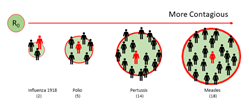Science Sleuths: The Science That Shapes Diagnostic Tests; What Does Ro Mean?
Ro, pronounced “R naught,” is a mathematically derived term used to indicate how contagious an infectious disease is. It is commonly referred to as the reproduction number of a disease. As a disease is transmitted to new people, it reproduces itself. Considering the current pandemic, this is an important topic to consider.

What does this mean for the veterinary community?
While the current pandemic and the use of Ro is geared specifically towards humans, it still works the same way with animal health. Veterinary epidemiologists, veterinarians and researchers utilize this method as well when studying disease outbreaks in animal populations.
How does it work and what does the number mean?
Ro tells you the average number of people (animals) that will contract a specific contagious disease from one person (animal) infected with that particular disease. Ro specifically applies to a population of people (animals) that were previously free of infection, haven’t been vaccinated (if available) and are at risk of contracting that disease.
The Ro value is only applicable when everyone in a population is vulnerable to a disease, such as the novel coronavirus COVID-19 that we are currently experiencing. When the Ro value is less than 1, each existing case will cause less than one infection in another person (animal) and at this point the disease will actually decline and eventually die out. If the Ro is equal to 1, the disease is will stay viable and stable without causing an increase in cases. If Ro is greater than 1, each case will cause more than one new infection. This will cause an increase of disease.
For example, say a disease has an Ro of 15, a person (or animal) that has the disease will, on average, transmit the disease to another 15 people (or animals). The disease will continue to propagate and spread this way if there is no protective immunity from either vaccination or previous exposure. According to the journal Emerging Infectious Diseases, the Ro for COVID-19 is approximately 5.7 as of July 2020. With an Ro of 5.7, we would need 82% of the population to be immune to COVID-19 to end the spread of new infections through vaccine and herd immunity.
The take home message
Once testing, modeling and analysis are complete, an Ro that is less than 1 means we are on the way to seeing a disease die out, while a number greater than 1 has potentially serious implications. We will be discussing these issues and concerns in future columns in the Equine Science Review. That means keep an eye out for our future articles.
Jackie Smith, PhD, MSc, MACE, Dipl AVES is an epidemiologist based at the University of Kentucky Veterinary Diagnostic Lab. Emma Adam, DVM, PhD, DACVIM, DACVS is based at the University of Kentucky Gluck Equine Research Center and Veterinary Diagnostic Lab and is responsible for research and serves as veterinary industry liaison.
